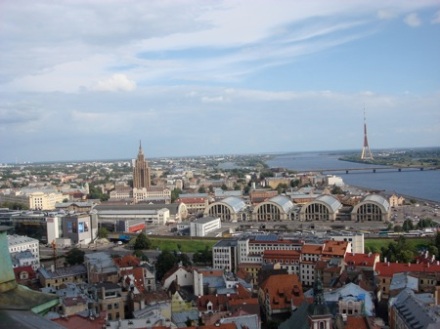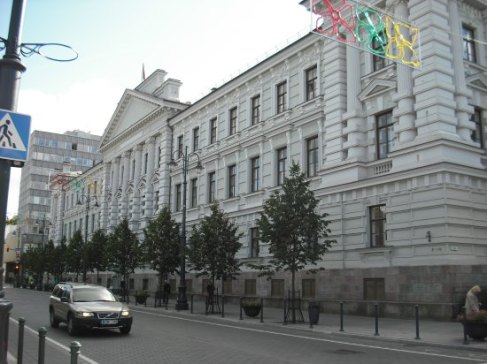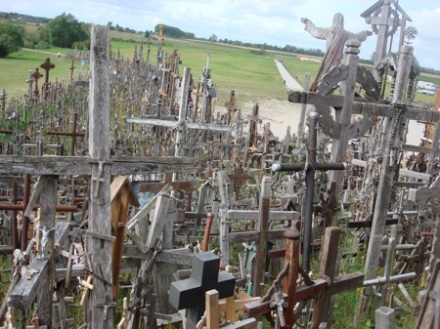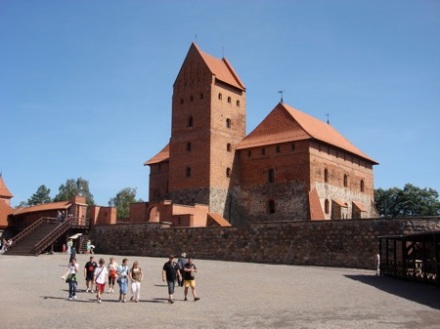In August of 2008, myself and my eldest brother set off to spend a little over a week in the Baltics. Armed only with a copy of Lonely Planet, a respectable grasp of high-school Russian (his, not mine), and a general delight at the pricing of Lithuanian beer, we flew out from Liverpool John Lennon Airport on a chilly English morning. Over the course of nine days, we encountered a mural to Frank Zappa, learnt that Lithuania’s famous friendliness is not a rumour (except in Kaunas), witnessed an American tourist giving the thumbs-up whilst having his photo taken in a former KGB cell (‘The Museum of Genocide’, Vilnius – a more enjoyable visit than it sounds!) and stayed in a former convent of some sort (oddly not a real first, having once spent a night in a convent school-turned hostel – yes, really – in Norway). So, if you wake up to find yourself in Latvia or Lithuania after a heavy night out, or, you know, decide to visit either or both countries, here are a few excellent things to see.
The quality of photos are mixed, but authentic, as I took them myself (with the exception of entry No. 4).
5.) Riga’s Central Market
One of the world’s largest markets, Riga’s central market was built between 1924-1930, and its outer frame is an incredible sight, built out of former German zeppelin hangars. Inside, both the scale, and the sheer wealth of available items are notable – the market selling, as it does, everything from cheeses, to postcards made by local merchants, and the obligatory stand or two of counterfeit DVDs. In recent years, the Market has become a little down at heel, but the astonishing exterior of the building, the Neoclassical design of its interior, and the ability to purchase anything from locally made crafts to Latvian delicacies, and to partake in some notable people watching, as the good, the bad and the peckish, descend upon the central market, is an opportunity not to be missed. Also the only place I’ve seen anyone wearing Man United’s blue and black striped away strip, since the mid ‘90s. Respect.
4.) Museum of Genocide Victims, Vilnius
I was tempted to put Vilnius’ historic old town (a UNESCO world heritage site) in, here, but it seems more fitting to put a single place of fascinating interest, above an area with a handful of sights. And ‘fascinating’ is the right word for Vilnius’ Museum of Genocide. Admittedly the title isn’t the most welcoming, and this is not a museum with pretentions of cheeriness. However, the array of artefacts, and the historical significance of much on show here, is staggering. Documents and photographs of the Forest Brothers, a Baltic group whom fought a guerilla battle against the Soviets in World War II, abound. There is a wealth of artefacts of torture from the KGB era (the building itself a former KGB headquarters), and some of the building’s rooms are unchanged from their original look, from when they were used as KGB interrogation cells, and entering them is a chilling and thoroughly unique experience. In 2010, an exhibition was added to the museum, relating to the death of Lithuanian Jews in the Holocaust; an exhibition which, if it has anything on the quality of those previously aired in the ‘Museum of Genocide Victims’, will provide thoroughly worthwhile for visitors.
3.) St. Peter’s Church, Riga
Originally built (and soon burnt down by a city fire) in the 13th century, the building that is now St. Peter’s Church was largely built in 1409-10, though the building’s “new tower” came about around 200 years later. The church itself is a wonderful building, with its spiky, gothic towers extending into the skyline. The brick façade of the building, from which the towers grow, is itself rather ornate and beautiful, though the two clock towers of the building are the most striking and memorable facets of the church. The viewing area from the top of the church provides an incredible 360-degree panorama of the City of Riga, and the views of Riga’s historic Old Town (another UNESCO world heritage site for us nerdy travellers to tick off!) are staggeringly beautiful, from here. A number of interesting historical artifacts, primarily relating to the build of the church, are on show inside St. Peter’s Church, and pausing to see them, on the walk up the tower, is well worthwhile. Simply spectacular.
2.) The Hill of Crosses (near the city of Šiauliai), Lithuania
As a man who loves his food, it is notable that my visit to the Hill of Crosses remains even more vivid in my memory than the delicious Pizza I had in Šiauliai on the same afternoon. The custom of placing crosses at the site is believed to originate from the ‘November Uprising’ (or more formally, the Polish-Russian war) of 1830-31 – a happening fuelled by a military insurrection in Poland, which spread north to Lithuania. The hill is a spectacular site, with the crosses innumerable, and varying in their material, size and design. There is one point upon the hill (paths run through the Hill of Crosses), where the crosses of Catholicism run for as far as the eye can see, and the size of the site is genuinely overwhelming. Small crosses, often of wooden design, hang upon larger, and often older crosses, with some dating back to the origin of the site, around 175 years ago, and devotional, Christian paintings abound, upon the site. Truly a marvellous, and momentous location.
1.) Trakai Island Castle, Lithuania
Affectionately known as “Little Marienburg”, Trakai Island Castle was completed in 1409, and was where Vytautus “the great” (self-styled, arrogant bastard) lived until his death in 1430. The Castle is of a faded orange stone, and is almost entirely complete, with only a few small corners beginning to fall away. The Castle is wonderful to walk around, replete with several yards, inner stair galleries, and best of all, a beautiful view out onto the lake of Trakai. With its plethora of pointed domes, ornate bridges, painstakingly-built walls (which look like they’d keep out the majority of intruders, even 600 years later), the Castle is absolutely marvellous. And, if you somehow find yourself tiring of walking around it, there are several wonderful spots for a quiet picnic, in the large, relaxing grounds outside the Castle walls. All it’s missing is a bar.





